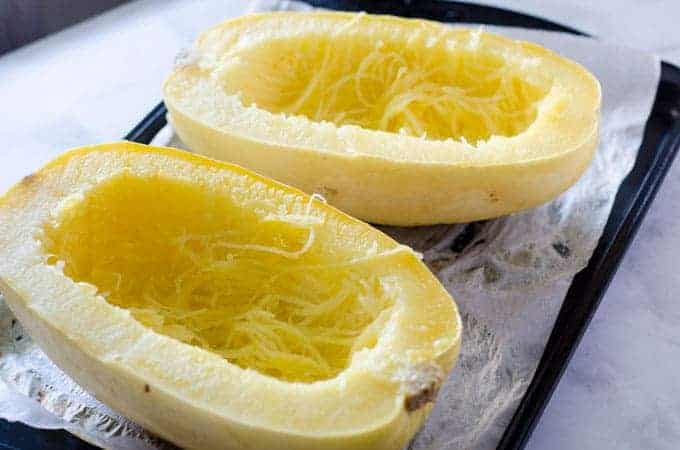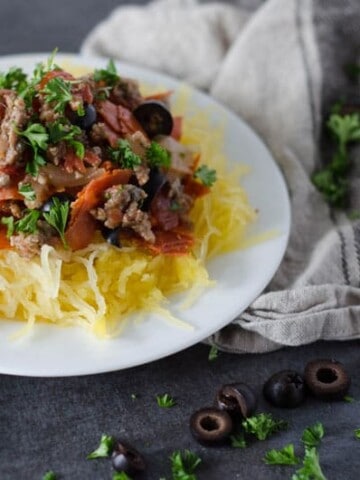Spaghetti squash is one of the larger winter squashes and is actually one of the easiest vegetables to cook. Here's how to bake a whole spaghetti squash in the oven to perfection every time!

It's a common (mis)belief that spaghetti squash is difficult to cook. I hear people say all the time that it's "too much work" and scraping the seeds is too hard. Well, they're right. It is too hard.
But here's the secret to cooking spaghetti squash - you don't have to scrape the seeds first.
Spaghetti squash is not only easy to cook, it's good for you, too! The health benefits of spaghetti squash are many.
There are also lots of posts out there on different ways to cook spaghetti squash in an Instant Pot/pressure cooker, air fryer or in a slow cooker. However, this method, in my opinion, is the best way because it doesn't require any special kitchen appliances - just a baking sheet and an oven.
It's my go-to method every time. Here's the easiest way to cook whole spaghetti squash in the oven to perfection!
1. Cut the squash in half.
You'll want to use a large, sharp knife for this. I use a 6" chef's knife. Spaghetti squash in its whole squash form can be a little bit awkward, as they are round in shape and can roll around. I use one hand to hold the spaghetti squash still (tightly) and use the other hand with the knife to press down into the raw squash.
Sometimes I find that bringing the cutting board and squash close to my body and pulling it in tightly allows me to push down with the tip of the knife into the outside of the squash, which makes it easier to get through the skin of the squash, which you can see in the video.
2. Prepare the pan.
Do not try and scrape out the seeds and insides of the squash at this point. Let me repeat that louder for those of you in the cheap seats:
DO NOT SCRAPE THE SEEDS.
Line your rimmed baking sheet with parchment paper and place the spaghetti squash cut side down on the prepared baking sheet, then add the water. Some of the water may seep under the parchment paper - this is ok.
The parchment paper keeps the squash from sticking to the pan. If you don't have parchment paper, that's ok too - you can do it without, you'll just have to scrub your pan a little when you're done.
What we're looking for is moisture underneath the squash to help steam it in the oven. This can still happen even if it's with damp parchment paper!
It should look something like this:

3. Cook the spaghetti squash in the oven.
We're going to cook the spaghetti squash as-is, no scraping necessary. Just stick it right in that preheated oven and let 'er go. Trust me on this one. You may need to adjust your cooking time depending on the size of your squash.
The 30 minutes is based on a medium sized spaghetti squash. If I have a smaller one I will often reduce it, and larger ones can need a bit more time. With a vegetable this large, cook times can vary up to 10-12 minutes, so adjust accordingly and check often.
Undercooked spaghetti squash will have a slightly al dente texture (aka it will be a little crunchy!) and overcooked will get mushy and lose it's strand-like texture.
Use the "squeeze test" to see if it's done. I've found this is a great way to determine if it needs a few more minutes. Give the sides a gentle squeeze. If the skin gives under a bit of pressure, and leaves a couple of markings in the soft spots from your fingers, it's done cooking.
If it is firm and resists you, it needs a bit more time. Once it's done, remove it from the oven.
4. Flip the halves and cool.
If you leave the squash halves face down on the paper, they will stay hot for a LONG time. They've built up a lot of steam inside, and the outer skin doesn't allow the heat to escape very quickly.
We won't be able to handle them immediately, but we want them to cool enough that we can handle them, so we can get the spaghetti-like strands out.
5. Scrape out the seeds and guts.
Once your halves are cool enough to handle, we are going to scrape the seeds out. They may still be hot on the outside; I often hold them in a potholder to make it easier.
I didn't take a picture of the cooked halves pre-scraping because I'm a dummy. You can see them in the video. The center will be soft and fork tender, and when you scrape with a large spoon, it will easily separate from the edible part.
Scrape the seeds and guts into the trash or compost. Some of the edible portion may start to scrape away; this is ok! Just focus on getting all the seeds and pulpy part out, like a halloween pumpkin.
Once you're done scraping the seeds, they should look like this:

6. Use a fork to shred the spaghetti squash into "noodles."
Confession: the novelty of this never wears off on me. Such a silly thing, but I love scraping out spaghetti squash noodles with a fork.
Hold your squash in one hand, and have a container ready that you're going to store your squash in, whether it's a bowl, Tupperware, or something else.
Using your other hand, take a fork and gently scrape the inside of the squash. For the best results, work in layers - don't try to scrape it all out in one big chunk, or you won't get these pretty little individual long strands you see here.

7. Use now or store for later.
Scrape both halves until you are left with just the empty tough skin. You may need to use the side of the fork instead of the tines to go around the inside edge, and these parts may not come out as perfect "strings." That's ok! Get all the insides out and toss the skins.

8. Decide how to use your cooked spaghetti squash.
I make spaghetti squash regularly in my weekly cook up, so I have it on hand to use in any number of ways.
If this is your first time working with it, you can keep it simple with a little olive oil, some meat sauce and a sprinkle of garlic powder.
Or, make a dish or casserole out of it! Here are a few of my favorite spaghetti squash recipes to get you started:
However you decide to use your squash, rejoice in the fact that that you no longer have to scrape the seeds before cooking. If you're anything like me, you'll start making these once every week or two to have on hand.
They're low carb and a great substitute for conventional noodles and in place of pasta. Spaghetti squash has a mild flavor and provides fair amounts of Vitamin C, Vitamin B6, and Manganese.
However you decide to use your squash, rejoice in the fact that you no longer have to scrape the seeds before cooking. 🙌🏻
Recipe

How to Bake a Whole Spaghetti Squash
Spaghetti squash is actually one of the easiest vegetables to cook. Here's how to bake a whole spaghetti squash in the oven to perfection every time!
Materials
- 1 large spaghetti squash
- ½ cup water
Tools
- parchment paper
- baking sheet
Instructions
- Preheat the oven to 350°.
- Line the baking sheet with parchment paper.
- Using a sharp knife, cut the spaghetti squash in half lengthwise.
- Place the two halves of the spaghetti squash face down on the parchment paper.
- Add the water to the pan.
- Bake the spaghetti squash for 30 minutes, or until the skin gives slightly when squeezed.
- Remove the pan from the oven and use a potholder to flip the halves over to allow them to cool.
- Once cool enough to touch, use a large spoon to scoop out the seeds.
- Use a fork to scrape the spaghetti squash out of the skin.
- Eat immediately or store in a tupperware for later use.
Notes
Spaghetti squash can vary widely in size. Depending on the size of your squash, you may need to decrease or increase cook time. The squeeze test is my go-to - if I give the squash a gentle squeeze and the skin gives, then it's done. If it feels firm and resists, it needs a bit more time.
When you scrape the seeds out, some of the "spaghetti strings" will start to come out too. That's ok. Get to a point where you've gotten the seeds and "guts" out, then start scraping the edible part.
I may earn a small commission off purchases made through affiliate links in this post from Amazon and other sellers. This helps me continue to run the blog and keep providing you fresh content. Thank you for your support!








Leave a Reply